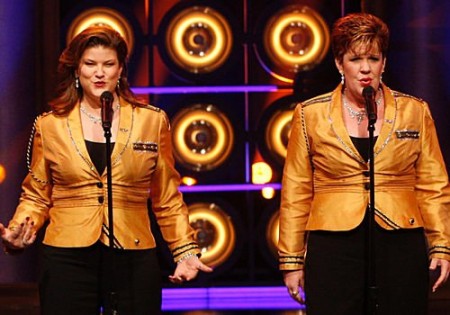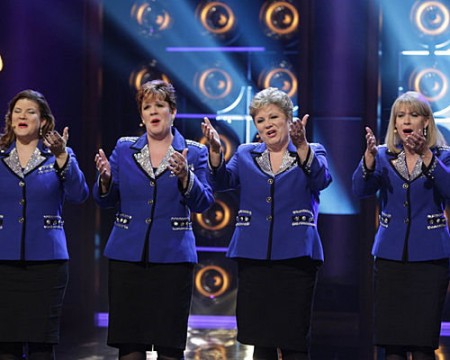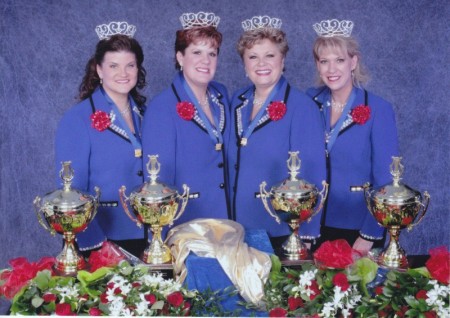Season 1 Sing-Off contestants MAXX Factor
Many of us will remember season one of The Sing-Off best for the emergence of Nota as one of the elite quartets in the world, or for The Beelzebubs’ ascent in the mainstream, or for the way in which Ben Folds transitioned from a talent on the fringe of Top 40 radio into a household name and much loved reality TV personality.

But arguably the most memorable splash of all came from MAXX Factor, a group of four women who unabashedly embraced old school barbershop swagger and, on multiple occasions, stole the show from their flashier counterparts. MAXX Factor grabbed hold of the public’s imagination through a crowd-pleasing, and at times awe-inspiring mix of covers from artists as diverse as ABBA, Taylor Swift, and Amy Winehouse.
Unlike those groups that have formed for the express purpose of excelling on The Sing-Off, MAXX Factor started years before the show, and has continued along just fine. After their run on NBC, the quartet went on to win the 2010 Sweet Adelines International Finals, and to this day maintain a busy touring schedule. The group also released a new CD late last month.

Valerie Hadfield-Rasnake, a founding member of the group, took the time to talk with me on a Wednesday morning. It should come as no surprise that her own beginnings in the a cappella world came at a very young age. Her father joined The Barbershop Harmony Society in 1961, and Valerie “grew up on Four Freshman, Boston Commons, The Kingsmen.” As she described the experience growing up around so much barbershop, “you either like it or you don’t, and I really liked. I went to conventions when I was ten or eleven years old and I just fell in love with it.”
A little-known bit of trivia: MAXX Factor started with only one “X.” Valerie and baritone Kim Hudson had sung in a quartet prior to the current configuration, and sought success in The Sweet Adelines competition. The original tenor parted from the group, and in came Molly Dalton Plummer, then Leslie Wodday joined the group on a stand-in basis, including singing the National Anthem alongside the rest of the ladies at a NASCAR event. Before long, Leslie was hooked. “We put the extra X on MAXX factor because now we really took MAXX to the next level," Valerie said. "Leslie had had already won at Nationals so this was the next step toward building something successful.”
Indeed, MAXX Factor was successful. Valerie recounted that the group competed regionally before making it the Sweet Adelines Internationals in Hawaii where they finished fourth in their first try. In 2009, they reached the international finals again, but had another major success to their name that they were not yet permitted to talk about. “The following year we competed in Nashville, but we had already tried out for The Sing-Off and knew we were on the show. NBC sent cameras to film there, but we couldn’t talk about it. We finished third, then flew to LA right afterward to prep for The Sing-Off.”

Although Valerie did, overall, describe the Sing-Off experience as “pretty awesome,” she also noted the significant challenges that came with performing on the show. The experience included “practicing, singing, dancing until midnight, and then dress fitting until three or four in the morning.” Despite the stress and challenges, Valerie went on to note “the other groups become your family; it wasn’t like you’re going to go out there and beat such and such group.”
Indeed, MAXX Factor seems to have found a unique communal experience backstage. Valerie described memories from times when MAXX Factor “sang together, then Nota came over and added percussion, then Noteworthy joined in. We hung out with everyone, and we were all so happy to be there and just singing.” She went on to describe the process of teaching members of Nota and The Beelzebubs barbershop harmony tags, which they weren’t used to prior to that point.
The first season of the show, by it’s very nature, was full of surprises. “Going into Sing-Off, first season, it was kind of the unknown. You didn’t know what to expect … [the show] was promoted but it was still questionable how the show would perform.” Valerie went on to observe that each of the groups was asked to branch out during season one, whereas in season two the show seemed to move in the direction of groups sticking with styles with which they were most experienced. “You saw it with Jerry Lawson—they didn’t seem to veer much from Drifters, doo-whop kind of music … they’re not going to be asked to do AC/DC ‘Back in Black.’”
Valerie had nothing but positive things to say about the show’s judging panel. “Shawn Stockman seemed to like our group because he started out with a quartet, so we connected right away. Ben [Folds] really appreciated what we could bring to the stage as four people, as opposed to a dozen. Nicole was fantastic.” Valerie was also very complimentary of the coaching and organizational skills Deke Sharon, who mentioned they had affectionately called "Papa Deke."
As a fan of MAXX Factor’s season one run on the show, I felt compelled to inquire about my favorite showing from the group—an inspired cover of Amy Winehouse’s “Rehab.” “I love it!” Valerie said. “Petra Haden was the arranger, and I only wish we could have raised it up a bit. A lot of stuff we did was lower key-wise, and I thought we could have rung it out a little more. It’s such a fun song.”

The experience of performing on The Sing-Off, paired with the group’s success in Sweet Adelines competition, MAXX Factor has had no shortage of opportunities to perform live. When Valerie spoke with me she was fresh off a performance in Wichita, KS for an engagement in which they performed in one of the oldest theaters in America, joining a lineage of stage performers that included Houdini. The group has literally crossed the country to perform in California. Furthermore, the group will take its act international in the months ahead, including the group’s first appearances in Israel and Ireland.
The quartet incorporates “lots of humor, and we tell lots of stories” between songs, Valerie said. They normally perform about a half hour set with a repertoire of 15-20 songs at any given time. The group also usually welcomes fans to meet with them for after parties following their shows.
MAXX Factor’s most recent concerts have been highlighted with selections from their new, eponymous CD. “This is our second CD. The first one had six songs on it. This one is brand new and has 14 tracks,” Valerie said. When pressed for a favorite selection, Valerie cited the group’s cover of “All the Way” by Frank Sinatra. It’s her favorite and seems to be fan favorite—the group hears a number of requests for it and often ends shows with that number. She also noted “Hey There” from The Pajama Game and “Yellow Brick Road” as examples of more modern arrangements.
We talked about the future of a cappella in general and Valerie expressed her belief that the form “probably can sustain [its popularity] for years. People have alwas done it and will keep doing it. I would love to see it go mainstream on the radio somewhere.” She also expressed her interest in newer technologies capitalizing on the a cappella niche, suggesting that a satellite radio station devoted exclusively to a cappella could be a major success.
When it comes to offering other groups advice on how they can succeed, Valerie advised musicians to “keep sticking with it. With the growth of a cappella and how popular it’s become, if you can sing a cappella, you can pretty much do anything … Keep with it and success will come. Keep doing what you love to do.”
All photos are courtesy of MAXX Factor. You can learn more about the quartet at the MAXX Factor website.